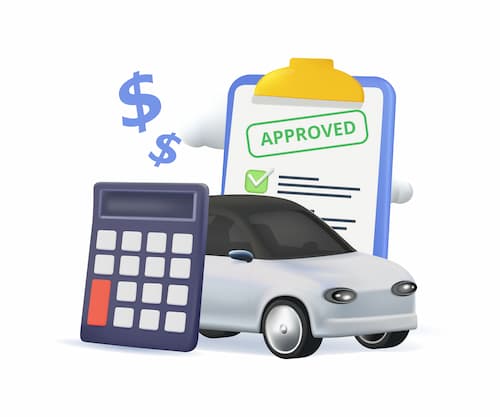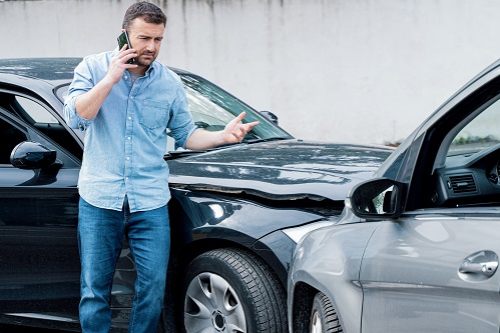- What's the difference between comprehensive and collision?
- Comprehensive vs. collision insurance: How much does each cost?
- Do both comprehensive and collision have a deductible?
- What is comprehensive insurance?
- What is collision insurance?
- Who needs comprehensive and collision insurance: Loans and budget
- How to get cheap comprehensive and collision insurance
- Comprehensive and collision claims: How to file, how it works
- Dropping comprehensive and collision insurance: How to decide
- Methodology
- FAQ: Real questions about comprehensive and collision insurance
What's the difference between comprehensive and collision?
Collision and comprehensive insurance both cover damage to your vehicle, but from different causes.
As the name suggests, collision insurance covers crashes. Specifically, it will pay for your vehicle’s repairs if
- You're at fault or there is no other insurance to pay for the damage.
- You are in a rollover
- You have a single-car accident where you strike something other than a vehicle, like a telephone pole.
Comprehensive insurance pays to repair or replace your vehicle after a non-collision incident that is out of your control. For example:
- Your car gets stolen
- Your car is vandalized
- Weather-related damage such as hail.
- Fire
- Animal accidents
The table below lists a few examples of claims and which type of insurance would apply to each.
| Cause of damage to your car | Which coverage pays? |
|---|---|
| Damage from hitting a boulder in the road | Collision |
| Damage from a boulder rolling into your car | Comprehensive |
| A tree limb falls onto the car roof | Comprehensive |
| Damage from hitting a fallen tree in the road | Collision |
| Smashed window from someone breaking into your car | Comprehensive |
| Window broken from a hit-and-run driver running into your car | Collision |
NOTE: Your car insurance rate is more likely to increase due to a collision claimAn insurance claim is a request you make to your insurance company for coverage after your car is damaged or you have an accident. You can file a claim online, by phone, or in writing. than a comprehensive claim. Collision claims are usually your fault, so your rate will likely rise. Typically, comprehensive claims are not at-fault incidents, so your rate may not increase much.
Comprehensive vs. collision insurance: How much does each cost?
On average, U.S. drivers pay:
- $421 per year for comprehensive coverage
- $743 per year for collision insurance
The cost of each coverage depends on a lot of factors, including your age, gender, location, driving record, credit score and the type of car you drive.
EXPERT TIP: The lower the value of your car, the less comprehensive and collision insurance will generally cost. That's because an insurer would have to pay less for a total loss.
The chart below breaks down collision and comprehensive insurance costs by state.
| State | Average comprehensive premium | Average collision premium | Average combined |
|---|---|---|---|
| Alaska | $233 | $818 | $1,051 |
| Alabama | $391 | $711 | $1,102 |
| Arkansas | $466 | $816 | $1,282 |
| Arizona | $252 | $671 | $923 |
| California | $224 | $1,208 | $1,432 |
| Colorado | $811 | $682 | $1,493 |
| Connecticut | $188 | $800 | $988 |
| Washington, D.C. | $266 | $1,018 | $1,284 |
| Delaware | $234 | $699 | $933 |
| Florida | $233 | $599 | $832 |
| Georgia | $330 | $708 | $1,038 |
| Hawaii | $156 | $717 | $873 |
| Iowa | $701 | $569 | $1,270 |
| Idaho | $235 | $695 | $930 |
| Illinois | $398 | $605 | $1,003 |
| Indiana | $325 | $637 | $962 |
| Kansas | $740 | $631 | $1,371 |
| Kentucky | $476 | $785 | $1,261 |
| Louisiana | $478 | $906 | $1,384 |
| Massachusetts | $230 | $784 | $1,014 |
| Maryland | $233 | $689 | $922 |
| Maine | $207 | $581 | $788 |
| Michigan | $522 | $1,091 | $1,613 |
| Minnesota | $671 | $699 | $1,370 |
| Missouri | $596 | $717 | $1,313 |
| Mississippi | $513 | $758 | $1,271 |
| Montana | $699 | $846 | $1,545 |
| North Carolina | $340 | $802 | $1,142 |
| North Dakota | $653 | $616 | $1,269 |
| Nebraska | $833 | $651 | $1,484 |
| New Hampshire | $189 | $626 | $815 |
| New Jersey | $183 | $716 | $899 |
| New Mexico | $444 | $830 | $1,274 |
| Nevada | $160 | $673 | $833 |
| New York | $314 | $645 | $959 |
| Ohio | $319 | $595 | $914 |
| Oklahoma | $591 | $750 | $1,341 |
| Oregon | $255 | $629 | $884 |
| Pennsylvania | $434 | $864 | $1,298 |
| Rhode Island | $194 | $961 | $1,155 |
| South Carolina | $390 | $579 | $969 |
| South Dakota | $1,246 | $651 | $1,897 |
| Tennessee | $319 | $743 | $1,062 |
| Texas | $448 | $725 | $1,173 |
| Utah | $236 | $711 | $947 |
| Virginia | $327 | $604 | $931 |
| Vermont | $227 | $733 | $960 |
| Washington | $185 | $606 | $791 |
| Wisconsin | $564 | $611 | $1,175 |
| West Virginia | $467 | $855 | $1,322 |
| Wyoming | $576 | $820 | $1,396 |
Do both comprehensive and collision have a deductible?
Comprehensive and collision insurance both have a deductibleThe deductible is the amount you pay out of pocket for a covered loss when you file a claim.. Most drivers choose the same deductible amount for both, but it's possible to have different deductibles for each coverage. The deductible is the amount you will pay before insurance covers anything when you file a claim.
A higher deductible will mean lower insurance costs, and vice versa.
EXPERT TIP: Because comprehensive car insurance costs less, it may be possible to carry a smaller deductible on that part of your coverage without much impact on your overall car insurance costs.
What is comprehensive insurance?
Comprehensive insurance is a type of auto insurance that pays for your vehicle’s repairs after a loss that is not caused by an accident. It’s often referred to as “other than collision” coverage.
What does comprehensive insurance cover?
Here are some types of losses that are covered by comprehensive insurance:
- Minor windshield damage
- Damage caused by falling or airborne objects like hail, rocks or tree branches
- Theft
- Vandalism
- Fire
- Natural disasters
- Civil disturbances
- Striking an animal
When you file a comprehensive claim, you must pay the deductible. For example, if you had a $10,000 claim and a $1,000 deductible, you would receive $9,000 from your insurance company.
What's not covered by comprehensive insurance?
Despite the name, comprehensive car insurance does not cover everything. Examples of items not covered by comprehensive insurance include:
- Vehicle repairs after an accident
- Intentional damage
- Medical bills
- Your personal items in the vehicle
How much is comprehensive insurance?
The average cost of comprehensive car insurance coverage is $421 a year. Comprehensive coverageComprehensive coverage helps pay for damage to your car caused by events other than a collision, such as theft, fire, vandalism, or natural disasters. It is subject to a deductible. is cheaper than collision coverage as the risks associated with this coverage are lower.
What is collision insurance?
Collision insurance pays for your vehicle’s repairs after an accident that you cause. It also covers single-vehicle crashes and rollovers.
What does collision insurance cover?
Here are some situations where collision insurance would come into play:
- Hitting a tree or telephone pole
- Crashing into a building
- Rolling or flipping your car
- Hitting a pothole or curb
- Backing into another car
Like comprehensive insurance, collision coverage also has a deductible.
If another vehicle is responsible for your car's damage, but you use your collision coverage to expedite repairs, you’ll still have to pay the deductible. However, your auto insurance company should subrogate (try to recover your repair costs from the at-fault party). If it collects from the other party, your deductible may be refunded.
How much is collision insurance?
The average collision insurance cost is $743 a year, significantly more than the cost of comprehensive coverage. Collisions are a greater risk for insurance companies than the non-collision damage comprehensive covers. As a result, collision costs more than comprehensive insurance and has more impact on your overall car insurance cost.
Who needs comprehensive and collision insurance: Loans and budget
You need both coverages if:
- You have a loan or lease on your vehicle (it will be required)
- You can't pay for repairs out of pocket (you could be left without a car)
"One of the biggest mistakes people make is not having the coverage," Peyton says. "Because it's almost always the person who can't afford an unexpected expense who decides to try and save a little money by dropping coverage."
How to get cheap comprehensive and collision insurance
Adding comprehensive and collision insurance to your auto insurance will cause your premium to increase. However, there are a few things you can do to reduce the cost of full coverage insurance:
- Bundle auto insurance with home insurance
- Choose a car that's less expensive to insure
- Improve your credit score
- Drive less
- Improve your driving record
- Increase your deductible
- Look for car insurance discounts
- Pay your annual premiums in full
- Sign up for a usage-based discount program
Peyton says that, by far, the best way to save on optional coverage for your car is to combine your auto and homeowners insurance. Other top discounts include savings for safe drivers and good students.
Comprehensive and collision claims: How to file, how it works
After the loss, you’ll need to document the damage and notify your insurance company of the incident. From there:
- The claims adjuster will investigate the loss
- They'll verify your coverage and determine whether collision or comprehensive applies
- You’ll then be offered a settlement to cover the cost of your vehicle’s repairs (or purchase a new vehicle if your car was totaled).
- The settlement will be issued minus your deductible
In a total loss, your settlement will be based on the actual cash value (ACV) of your vehicle minus a deductible. This means that depreciation is factored into the value of your car.
Dropping comprehensive and collision insurance: How to decide
As a general rule, if your premiums and deductibles for comprehensive and collision insurance are equal to or greater than the fair market value of your vehicle, you can drop the coverage.
If your premiums exceed 10% of your potential payout, carrying full coverage might not be worthwhile.
For example, if your car is worth $3,000 and you have a $500 deductible, your potential payout would only be $2,500. Using the 10% rule, if your collision and comprehensive coverage cost $250 or more a year, consider canceling the coverage.
EXPERT TIP:Because these coverages tend to get cheaper as your car gets older, you can keep them at a lower cost, even on an older car.
Of course, if you still have a loan on your car, you will have to keep the coverage until it’s paid off.
Methodology
We partnered with Quadrant Information Services to field car insurance rates across all 50 states and Washington, D.C.
National and state average rates are based on three coverage levels: state minimum, 50/100/50 liability-only, and full coverage with 100/300/100 liability and $500 deductibles.
Unless otherwise indicated, averages are based on our full coverage data set. This data set is based on:
- 12-mile commute, 10,000 annual mileage
- Bodily injury liability of $100,000 per person and $300,000 per incident
- Property damage liability of $100,000 per incident
- Comprehensive and collision deductibles of $500
- 40-year-old driver
- Honda Accord LX
- Good credit
- A clean driving record
Learn more about our data and methodology.
FAQ: Real questions about comprehensive and collision insurance
How does liability insurance differ from comprehensive or collision insurance?
Liability insurance covers only damage you cause to others in an at-fault accident. It doesn't cover any damage to your car in any circumstances. Comprehensive and collision cover damage to your vehicle.



